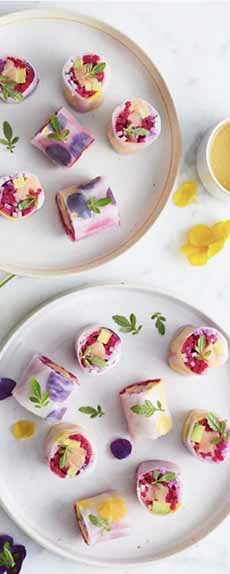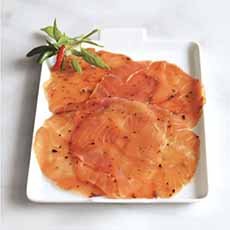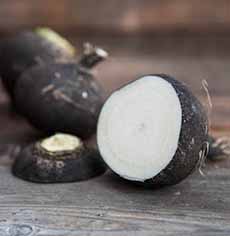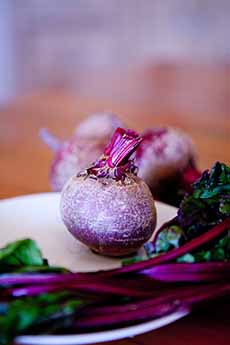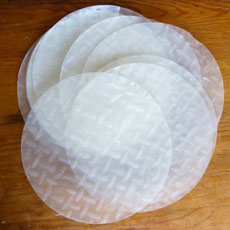Smoked Salmon Spring Rolls Recipe
|
Our friends at Petrossian shared with us this delightful recipe for smoked salmon summer rolls. They are as much a treat for the eye as for the palate (photo #1). Petrossian calls them maki, the Japanese word for roll; but they are more correctly namu harumaki that are sliced in the manner of sushi maki. The difference is in the wrapper. The rolls are accompanied by a sesame oil vinaigrette for dipping. See recipe variations below. Prep time is 45 minutes. Rest time is 30 minutes 1. SLICE the beet and black radish into sticks. Cut the smoked salmon into ½ inch wide slices. Slice the avocado into thin slices. 2. DIP the sheets of rice paper one by one into warm water. Once wet, place on a clean, flat kitchen towel. At the bottom of each sheet, lay a few edible flowers and cilantro leaves, a few slices of beet and radish, smoked salmon and finally the sliced avocado. 3. FOLD the left and right sides of the rice paper inwards, and roll the spring roll up, squeezing tightly. Let sit in the refrigerator for 30 minutes uncovered. While the rolls are resting… 4. MAKE the vinaigrette. Mix the ingredients in a small bowl. When ready to serve… 5. SLICE the spring rolls into pieces of the same size. Serve alongside the vinaigarette. Garnish the plate with a few edible flowers and/or snipped herbs. *The black radish (Raphanus sativus)—white flesh with a sooty-colored skin—is the oldest cultivated of all radishes. Its cultivation precedes the building of the pyramids in Egypt. It was commonly grown in the United States in the 1800s, as a winter crop, but dropped from favor in the 1900s, appearing mostly in farmers markets. black radish is grown as a winter crop. The flavor varies from mild to spicy, like red radishes, to almost as hot as horseradish. The texture is crisp but it is much tougher than other radishes. All radishes are members of the Brassicaceae plant family that includes the cruciferous vegetables, nutritional powerhouses packed with potent, cancer-fighting phytonutrients (antioxidants). They include arugula, bok choy, broccoli, Brussels sprouts, cabbage, cauliflower, horseradish/wasabi, kale, kohlrabi, mustard, radish, rapeseed/canola, rapini, rutabaga and turnips, among others. |
|
|
|
|
||
